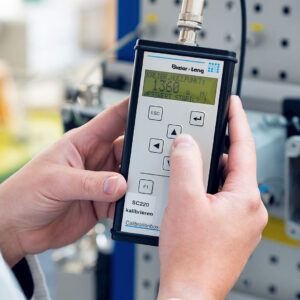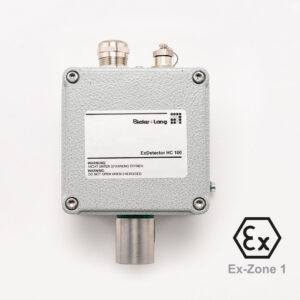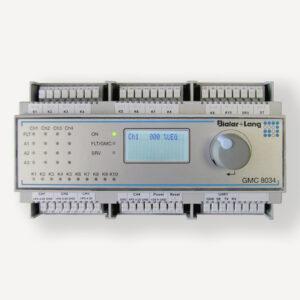Hydrogen (H₂)
Clean energy source, high hazard potential
Hydrogen is considered a key technology in the energy transition – at the same time, handling the lightest of all gases places high demands on safety technology. This is because hydrogen is extremely volatile, highly explosive and colorless and odorless – leaks usually go unnoticed without suitable detection.
Special properties of hydrogen
- Very low ignition energy – even a static discharge is sufficient
- Wide explosion limit: approx. 4 % to 75 % vol. in air
- Rapid diffusion – spread even through the smallest openings
- Particularly relevant for electrolysis, fuel cells, battery rooms and laboratories
Hydrogen as an important energy source of the future
Hydrogen is not only an important industrial gas, but is also developing into a key energy source in the energy transition. However, hydrogen differs considerably from other fuels in terms of its properties and risks. With the growth of the global hydrogen economy, hydrogen plays a crucial role in the decarbonization of the global energy supply. However, the safe use of hydrogen requires strict safety precautions, in particular through the use of reliable hydrogen gas warning systems.
Why hydrogen as an energy source?
The fossil fuels currently in use are limited and harmful to the environment. Renewable energies are therefore gaining in importance, but also pose challenges, such as the storage of energy from intermittent sources such as wind and sun. Hydrogen offers a solution here:
- Energy storage: Electrolysis can be used to store surplus renewable energy in hydrogen.
- High energy density: Hydrogen has a higher energy density than batteries and produces no harmful emissions when used – the only by-product is water. The advantages of hydrogen make it a key technology in a zero-emission future. According to forecasts, the global hydrogen market is growing by around 6% annually and will reach a value of 155 billion US dollars by 2022.
Risks when handling hydrogen
Despite its advantages, hydrogen also harbors considerable risks:
- Risk of leakage: Hydrogen is the smallest molecule in the universe and can easily diffuse through many materials.
- High flammability: Hydrogen is flammable between 4% and 75% by volume in air – compared to methane (4.4%-17%). Even minimal amounts of energy of 0.017 mJ can ignite a hydrogen-air mixture.
These properties make it essential to install high-quality hydrogen gas warning systems.
Hydrogen and gas detection technology
As hydrogen is odourless, colorless and tasteless, specialized sensors for leak detection are essential. Our gas warning systems detect critical H2 concentrations in the ambient air and react automatically with acoustic and visual warning signals, the activation of ventilation systems or the shutdown of affected system components. Gas warning systems usually consist of gas sensors that can be positioned precisely, central evaluation units and interfaces to building automation or emergency stop systems. Two sensor technologies are particularly suitable for the reliable detection of hydrogen:
Pellistor sensors
- How it works: A catalyst triggers combustion of the gas at low temperatures, the heat generated is measured and the gas content is displayed as a percentage of the lower explosion limit (%LEL).
- Advantages: Robust, cost-effective and reliable – ideal for general hydrogen monitoring applications.
Electrochemical sensors
- How it works: Hydrogen reacts with an electrolyte, which generates a proportional current.
- Advantages: High sensitivity (measuring ranges from 0-1000 ppm to 0-40,000 ppm), ideal for applications where low hydrogen concentrations need to be detected.
Unsuitable technologies
- Infrared sensors: Cannot detect hydrogen, as diatomic molecules do not absorb IR radiation.
- Semiconductor sensors: React to many other gases, which can lead to false alarms.
Our gas warning systems reliably detect hydrogen – even at the lowest concentrations.
Rely on over 50 years of experience in hydrogen detection – Made in Germany.
For safe applications in industry, research and energy technology.
Our gas detection systems offer maximum precision and reliability:
- Addressable detectors for safe areas or potentially explosive zones (ATEX/IECEx).
- Aspirating detectors for areas that are difficult to access, such as clean rooms.
- Ex-Detector-X5: Standalone detectors with versatile application options, including dual gas sensors.
- Ex-Detector HC 100: Robust sensor with comprehensive certifications
- Large product portfolio around H2
Get in touch with us
Find out more about our hydrogen gas detection systems and accessories such as collecting funnels and remote gas connections. Talk to our team of experts and find the right solution for your specific application!
- Hydrogen gas warning systems
- Hydrogen leak detection
- Hydrogen monitoring systems
- Hydrogen safety
- ATEX-certified Gas Detectors
- Hydrogen sensors
- Hydrogen Gas Detectors for Industry
Products for hydrogen gas warning devices:
Gas warning systems usually consist of gas sensors that can be positioned precisely, central evaluation units and interfaces to building automation or emergency stop systems. We will be happy to advise you on the appropriate and standard-compliant design of your gas warning system in the hydrogen sector and Ex zones 1 and 2.








